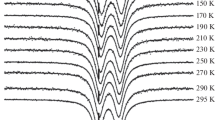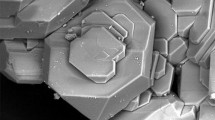Conclusions
The Mössbauer spectra of iron phosphides at 65°K were recorded for the first time. It was established that in the Fe3P, FeP, and FeP2 crystal structures, the crystallographically equivalent positions of iron are not equivalent with respect to the magnitude of effective magnetic field or of electric field gradient on the nucleus. Mössbauer spectra enable phase analysis to be carried out on iron phosphide powders.
Similar content being viewed by others
Literature cited
I. M. Fedorchenko, G. M. Derkacheva, and I. I. Panaioti, “Effect of phosphorus on the friction properties of a material based on alloyed iron,” Poroshk. Metall., No. 11, 99–101 (1969).
O. A. Panasyuk and I. D. Radomysel'skii, “Effect of phosphorus additions upon the magnetic properties of parts from iron powder,” Poroshk. Metall., No. 3, 23–26 (1973).
Yu. F. Shkaravskii, L. Ya. Kulik, and V. B. Chernogorenko, “Investigation of the conditions of extraction-titrimetric determination of phosphorus in compounds of the iron-phosphorus system,” Zavod. Lab.,42, No. 2, 141–142 (1976).
E. Fluck, W. Kerler, and W. Neuwirth, “Der Mössbauer-Effekt und seine Bedeutung für die Chemie,” Angew. Chem.,75, No. 7, 461–472 (1963).
S. S. Hanna, “Direction of the effective magnetic field at the nucleus in ferromagnetic iron,” Phys. Rev. Lett.,4, No. 9, 513–515 (1960).
O. N. Razumov, A. A. Galushko, V. V. Gorskii, and V. N. Antonov, “Mathematical processing with the JPA-5 computer under conditions of a link-up with experimental apparatus,” Preprint, Institute of Materials Science, Academy of Sciences of the Ukrainian SSR, Kiev (1974).
R. E. Bailey, “Mössbauer and nuclear magnetic resonance studies of several iron phosphides,” Inorg. Chem.,6, No. 8, 1444–1447 (1967).
V. V. Bondar', V. A. Povitskii, and E. F. Makarov, “Mössbauer investigation of amorphous ferromagnetic iron-phosphorus alloys,” Fiz. Met. Metalloved., No. 5, 1061–1064 (1950).
E. Koster and B. L. Turreli, “NMR studies of Fe2P and Fe3P,” J. Appl. Phys.,42, No. 4, 1314–1315 (1971).
R. Wäppling, L. Häggström, S. Rundqvist, and E. Karlsson, “Mössbauer study of phosphides containing iron,” J. Solid State Chem.,3, No. 4, 276–292 (1971).
K. Sato, K. Adach, and E. Ando, “Mössbauer effect of Fe2P,” J. Phys. Soc. Jpn.,26, No. 3, 855–858 (1969).
R. Wäppling, L. Häggström, T. Ericsson, et al., “First-order magnetic transition, magnetic structure, and vacancy distribution in Fe2P,” J. Solid-State Chem.,13, No. 3, 258–271 (1975).
S. Rundqvist, “Phosphides of the B31 (MnP) structure type,” Acta Chem. Scand.,16, No. 3, 287–292 (1962).
H. Holseth and A. Kjekhus, “Structural and magnetic properties of FeP,” Acta Chem. Scand.,22, No. 4, 3284–3292 (1968).
H. Kasper and H. L. Drickhamer, “Nuclear magnetic resonance of FeP2,” Proc. Natl. Acad. Sci. U.S.A.,60, No. 3, 773–775 (1968).
Author information
Authors and Affiliations
Additional information
Translated from Poroshkovaya Metallurgiya, No. 1(229), pp. 57–61, January, 1982.
Rights and permissions
About this article
Cite this article
Nemoshkalenko, V.V., Tomashevskii, N.A., Chernogorenko, V.B. et al. Mössbauer spectroscopy of iron phosphide powders. Powder Metall Met Ceram 21, 50–53 (1982). https://doi.org/10.1007/BF00791726
Received:
Issue Date:
DOI: https://doi.org/10.1007/BF00791726




